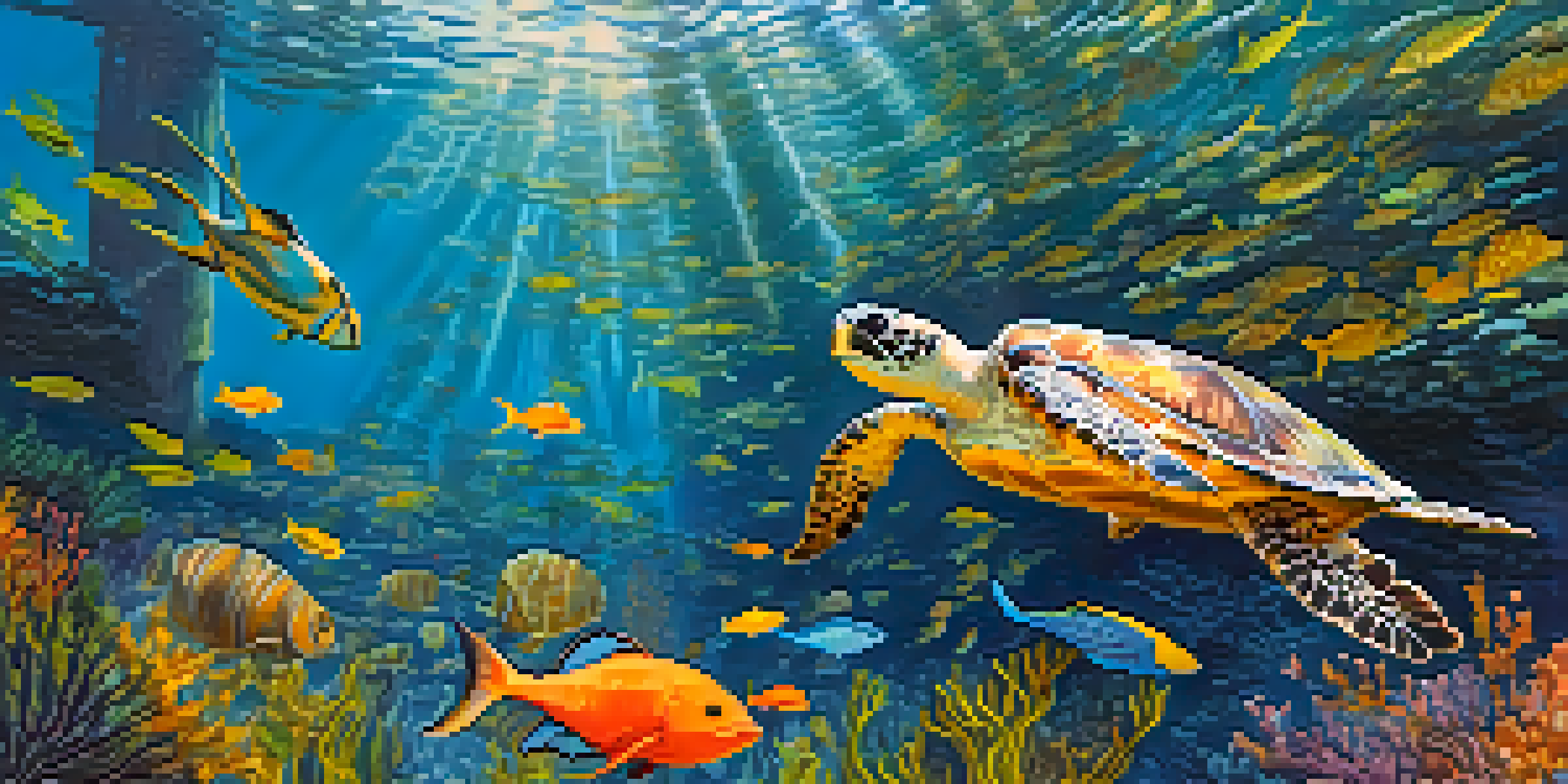Exploring San Diego's Marine Conservation Initiatives

An Overview of San Diego's Marine Ecosystems
San Diego is home to a rich variety of marine ecosystems, ranging from tidal pools to kelp forests. These environments support an array of marine life, including colorful fish, sea turtles, and even the occasional dolphin. With its unique coastal geography, the region plays a crucial role in biodiversity, making it essential to protect these habitats.
The ocean is a central part of our lives, and we need to protect it for future generations.
The coastal waters are not just beautiful; they are vital for the health of our planet. Healthy marine ecosystems help regulate climate, support fish populations, and provide recreational opportunities for locals and tourists alike. Understanding the importance of these ecosystems is the first step toward effective conservation efforts.
However, these delicate ecosystems face numerous threats, such as pollution, climate change, and overfishing. As awareness grows about these challenges, San Diego has taken significant steps to combat these issues and safeguard its marine environments for future generations.
Key Marine Conservation Organizations in San Diego
Several organizations in San Diego are dedicated to marine conservation, each focusing on different aspects of preservation. One prominent group is the San Diego Marine Conservation Society, which works tirelessly to protect marine habitats and promote sustainable practices. Their initiatives range from beach clean-ups to educational programs aimed at raising public awareness.

Another key player is the Ocean Discovery Institute, which engages young minds through hands-on marine science education. By inspiring the next generation, they aim to empower youth to become stewards of the ocean. This educational approach creates a lasting impact, helping kids understand the importance of marine ecosystems.
Diverse Marine Ecosystems in San Diego
San Diego boasts a variety of marine ecosystems that are essential for biodiversity and the health of our planet.
Collaboration among these organizations, local governments, and the community is crucial. Together, they tackle issues like ocean pollution and habitat restoration, creating a more comprehensive approach to marine conservation in San Diego.
Legislation Supporting Marine Conservation
Legislation plays a pivotal role in shaping marine conservation efforts in San Diego. The California Coastal Act, for instance, aims to protect coastal resources and ensure sustainable development. This legislation provides guidelines for managing coastal areas, helping to balance ecological health with human activity.
In every community, there is work to be done. In every nation, there are wounds to heal. In every heart, there is the power to do it.
Additionally, the Marine Life Protection Act establishes marine protected areas (MPAs) that serve as safe havens for marine species. These MPAs restrict certain activities to allow ecosystems to recover and thrive. San Diego has several MPAs, which have become crucial for the conservation of local marine biodiversity.
As policymakers continue to advocate for stronger protections, the community's involvement is essential. Public support for legislation not only raises awareness but also encourages lawmakers to prioritize marine issues in their agendas.
Community Engagement in Conservation Efforts
Community involvement is at the heart of San Diego's marine conservation initiatives. Local residents often participate in clean-up events, educational workshops, and citizen science projects. These activities not only foster a sense of ownership but also build a community dedicated to protecting local marine life.
Programs like 'Adopt-A-Beach' encourage volunteers to take an active role in maintaining clean beaches. By engaging with the environment, community members learn about the direct impact of pollution on marine ecosystems. This hands-on experience can be a powerful motivator for ongoing conservation efforts.
Community Engagement Drives Conservation
Local residents actively participate in conservation initiatives, fostering a strong sense of ownership and responsibility for marine life.
Moreover, local businesses are increasingly joining the cause by adopting sustainable practices. This shift not only benefits the environment but also resonates with eco-conscious consumers, creating a win-win situation for both the community and marine conservation.
Educational Programs and Their Impact
Education is a cornerstone of San Diego's marine conservation strategy. Various programs focus on informing the public about marine ecosystems and the challenges they face. Schools often include marine science in their curricula, highlighting the importance of ocean health at a young age.
Institutions like the Birch Aquarium at Scripps play a vital role in marine education. Through interactive exhibits and programs, visitors learn about the ocean's wonders and the importance of conservation. Such experiences can ignite a passion for marine life and motivate individuals to get involved.
Additionally, workshops and community events help bridge the gap between science and the public. By making complex scientific concepts accessible, these programs empower people to take action, whether through advocacy or personal lifestyle changes that support marine conservation.
Innovative Technologies in Conservation
Technology is revolutionizing marine conservation efforts in San Diego. Innovative tools like drones and underwater robots are being used to monitor marine health and track wildlife populations. These technologies allow researchers to gather data more efficiently and make informed decisions regarding conservation strategies.
Moreover, data analytics and modeling help predict the impact of climate change on marine ecosystems. By understanding these potential changes, conservationists can develop proactive measures to protect vulnerable species and habitats. This forward-thinking approach is crucial in an era of rapid environmental change.
Legislation Supports Marine Protection
Key laws like the California Coastal Act and Marine Life Protection Act are crucial for safeguarding San Diego's marine environments.
Community-driven apps also play a role in conservation, enabling citizens to report pollution or sightings of endangered species. This real-time data collection empowers individuals to contribute to conservation efforts, demonstrating that everyone can play a part in protecting the ocean.
Challenges and Future Directions in Conservation
Despite significant progress, San Diego's marine conservation efforts face ongoing challenges. Climate change continues to threaten marine ecosystems, leading to issues such as ocean acidification and rising sea temperatures. Addressing these global challenges requires local initiatives to adapt and evolve.
Additionally, balancing human activity with conservation is an ongoing struggle. As tourism and development increase, it's essential to find sustainable solutions that protect marine habitats while supporting the local economy. This balancing act is crucial for the long-term success of conservation efforts.

Looking ahead, collaboration among stakeholders will be key. By uniting government agencies, non-profits, and the community, San Diego can create a robust framework for marine conservation that not only addresses current challenges but also preserves its vibrant marine life for future generations.